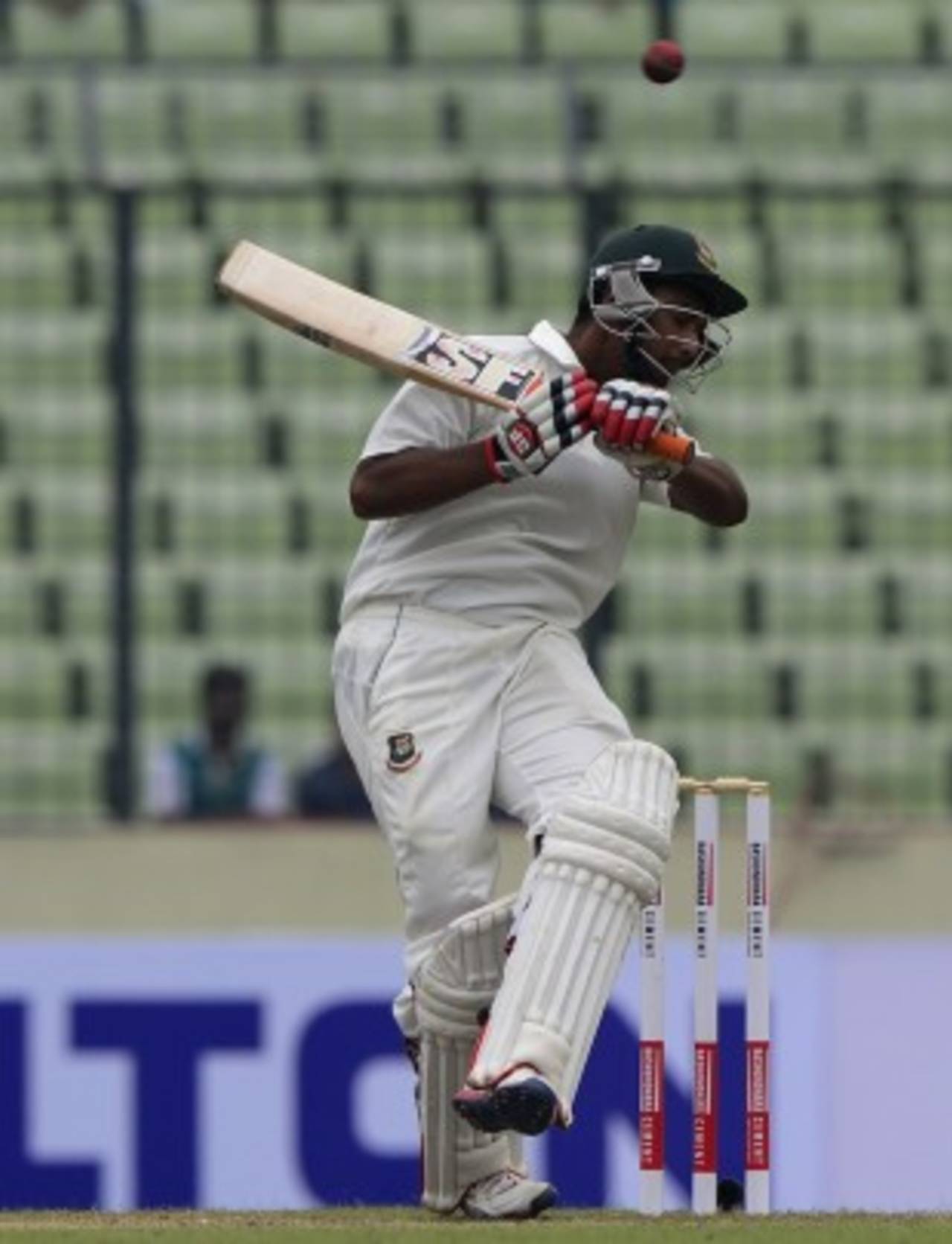The futility of Bangladesh's fifties
Conversion of fifties to hundreds has been a problem for Bangladesh. When their batsmen again found ways of getting out after reaching half-centuries, it reeked of casualness. Fifties don't take you too far in Tests
Devashish Fuloria in Mirpur
26-Oct-2014

Mahmudullah did well to stay restrained until Brendan Taylor introduced a part-time bowler • AFP
When Shakib Al Hasan mentioned a goal of at least 350 in the first innings, he would have known that to hit that figure, someone in Bangladesh's line-up would need to score a big hundred, supported by two or three fifties plus a few other useful contributions. There could be other combinations too but all of them would involve heavy scoring.
A template of how to get close to 400 was available from the concurrent Test being played in Dubai. Pakistan reached 454 on the back of two hundreds and three fifties. Australia had a centurion in their ranks, but without anyone else contributing, they barely passed 300. Bangladesh also had the example of Zimbabwe's innings. The message: just fifties wouldn't take you too far in Tests.
So when on a known pitch and against a team of medium-pacers and friendly spinners, the home batsmen found ways of getting out soon after reaching fifties, it reeked of casualness. Three set batsmen were guilty of gifting their wickets away - Mominul Haque was run out for 53 at the stroke of lunch due to his own mistake, Mahmudullah played across the line to be lbw for 63, just before tea, and Mushfiqur Rahim pulled one from outside off straight to square leg on 64. The three were the top scorers for their team. Their grand total: 180 runs.
"Yes a bit of it is due to the casual approach," Mahmudullah said. "If we were a bit more concerned, these mistakes would not have happened. I don't think the lead we have will give us any relief. I thought the wicket was really good today, even though they bowled in good areas. (Given) the wicket and the conditions, we should have done well. It wasn't spinning or bouncing. We should have batted with a lot more patience, especially those who scored fifties. The shot-making and decision-making, there were problems in these areas and we need to be more careful."
The batsmen actually showed a lot of patience in the morning. Mominul was the most assured at the crease and had seen through a tidy opening spell from the Zimbabwe seamers. It was surprising, therefore, to see a methodical batsman, born in the 1990s, failing to slide his bat in and being run out. Like diving and sliding, one would assume these basics would be part of the new DNA but in the age of big-data analysis, the simple things probably get sidelined. It was the third time Mominul was dismissed in the fifties in five Test innings.
Mominul's departure was followed by a loud cheer from the eastern stand of the ground as Shakib walked in. The rest of the stadium was sparsely populated but the energy emanating from that one stand affected Mahmudullah's composure. He stepped out of the crease for the first time in his innings, hit a six, and repeated it next ball. What perhaps worked for Bangladesh was that it was the last over before lunch and the batsman regained his composure after the break.
For someone who likes to play his shots, Mahmudullah would have felt straitjacketed in his innings. He did well to stay restrained until Brendan Taylor coaxed the real Mahmudullah out with the introduction of a part-timer. The result: Mahmudullah chose to play the sweep for the first time and was trapped in front. This was Mahmudullah's third fifty-plus score in four innings. The highest: 66.
Mushfiqur's case could probably be defended. He was batting along with No. 8 and wanted to keep the strike against the new ball. However, his choice of pull was likely to fetch him four runs rather than one as there was no protection behind square leg. It was Mushfiqur's fourth dismissal in the sixties in his last 12 innings; only twice has he gone ahead. He was the seventh wicket to fall and Zimbabwe did not take long to clean up the rest.
Since arriving on the Test scene, the conversion of fifties to hundreds has been a problem area for Bangladesh. In the last few years, they have started putting up taller scores, but the familiar pattern of batsmen taking injudicious risks immediately after crossing a landmark has plagued the team. In the last three years, only 13 centuries have come against 43 fifties. The landmark mist is not something rare; most tend to lose concentration, but while it happens for batsmen usually after reaching a hundred, the lid has been coming off a bit too early for Bangladesh. And it often leads to such totals.
Although the towers poured light throughout a murky day, it wasn't quite England. These were still good batting conditions. It may not be the same when Bangladesh bat second as the pitch might break up. That would also bring Zimbabwe's spinners into the picture. Bangladesh would hope they don't repeat elementary mistakes such as Mominul's but scoring big is a larger issue that their batsmen need to master.
"We need to be more careful in those periods because that's when you cash in," Mahmudullah said. "We need to learn. Maybe we are still learning."
Devashish Fuloria is a sub-editor at ESPNcricinfo